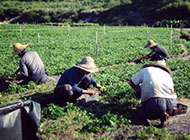 Agriculture in the Sydney Basin makes an important contribution to the economic development of western Sydney, and represents a significant proportion of NSW’s production of perishable food. Agricultural production in Sydney was worth $924 million in 2011. Account for the multiplier effect in the food sector, it contributes $4.5 billion to the local economy. The vegetables produced in the Sydney region account for 22% ($167 million) of total NSW vegetable production (Malcolm and Fahd, 2009). At certain times of the year, the Sydney region is the source of 90% of NSW’s vegetable products. According to the Sydney Peri-Urban Network, the Hawkesbury area is the leader in perishable vegetables in NSW, while Gosford is both NSW and Australia’s number one producer of chicken meat.
Agriculture in the Sydney Basin makes an important contribution to the economic development of western Sydney, and represents a significant proportion of NSW’s production of perishable food. Agricultural production in Sydney was worth $924 million in 2011. Account for the multiplier effect in the food sector, it contributes $4.5 billion to the local economy. The vegetables produced in the Sydney region account for 22% ($167 million) of total NSW vegetable production (Malcolm and Fahd, 2009). At certain times of the year, the Sydney region is the source of 90% of NSW’s vegetable products. According to the Sydney Peri-Urban Network, the Hawkesbury area is the leader in perishable vegetables in NSW, while Gosford is both NSW and Australia’s number one producer of chicken meat.
Agriculture, with its high labour requirements – especially for intensive agriculture – provides significant employment for people living in adjacent areas – areas that tend to experience high average levels of unemployment. The sector directly employed 7,069 workers on 2,210 farms in 2011. In addition to the direct loss of farming jobs, loss of agriculture is linked to the loss of employment in significant secondary industries associated with food processing, packaging and transportation.
Agricultural production in the Sydney Basin is worth at least $924 million, employing around 7,000 people.
Agricultural industries are also an important source of employment for culturally and linguistically diverse backgrounds – for migrants who can bring their knowledge of agriculture from overseas and who may not have a wealth of alternative employment options available to them in Australia.
Finally, peri-urban agriculture has agri-tourism economic development potential in its unique appeal for tourists: farmgate trails, cellar doors, pick-your-own-fruit weekends and farmers’ markets are potentially-lucrative alternative sources of income for farmers, and can increase the total income brought into the region. For example, Hawkesbury Harvest provides alternate distribution channels, such as the Farm gate Trail and Farmers Markets.